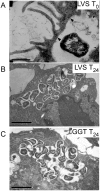Glutathione provides a source of cysteine essential for intracellular multiplication of Francisella tularensis
- PMID: 19158962
- PMCID: PMC2629122
- DOI: 10.1371/journal.ppat.1000284
Glutathione provides a source of cysteine essential for intracellular multiplication of Francisella tularensis
Abstract
Francisella tularensis is a highly infectious bacterium causing the zoonotic disease tularemia. Its ability to multiply and survive in macrophages is critical for its virulence. By screening a bank of HimarFT transposon mutants of the F. tularensis live vaccine strain (LVS) to isolate intracellular growth-deficient mutants, we selected one mutant in a gene encoding a putative gamma-glutamyl transpeptidase (GGT). This gene (FTL_0766) was hence designated ggt. The mutant strain showed impaired intracellular multiplication and was strongly attenuated for virulence in mice. Here we present evidence that the GGT activity of F. tularensis allows utilization of glutathione (GSH, gamma-glutamyl-cysteinyl-glycine) and gamma-glutamyl-cysteine dipeptide as cysteine sources to ensure intracellular growth. This is the first demonstration of the essential role of a nutrient acquisition system in the intracellular multiplication of F. tularensis. GSH is the most abundant source of cysteine in the host cytosol. Thus, the capacity this intracellular bacterial pathogen has evolved to utilize the available GSH, as a source of cysteine in the host cytosol, constitutes a paradigm of bacteria-host adaptation.
Conflict of interest statement
The authors have declared that no competing interests exist.
Figures








References
-
- Titball RW, Sjostedt A, Pavelka MS, Jr, Nano FE. Biosafety and selectable markers. Ann N Y Acad Sci. 2007;1105:405–417. - PubMed
-
- Sjostedt A. Tularemia: history, epidemiology, pathogen physiology, and clinical manifestations. Ann N Y Acad Sci. 2007;1105:1–29. - PubMed
-
- Barker JR, Klose KE. Molecular and genetic basis of pathogenesis in Francisella tularensis. Ann N Y Acad Sci. 2007;1105:138–159. - PubMed
Publication types
MeSH terms
Substances
LinkOut - more resources
Full Text Sources
Other Literature Sources
Molecular Biology Databases
Miscellaneous

